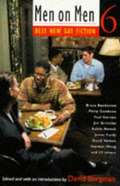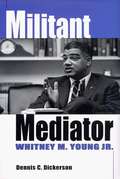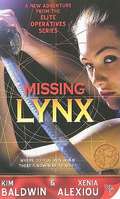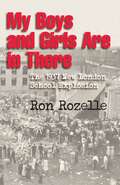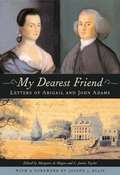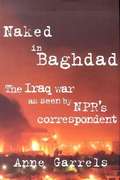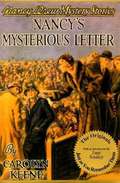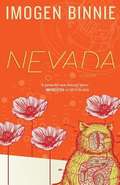- Table View
- List View
Men On Men 6: Best New Gay Fiction
by David BergmanSensual masseurs and seductive lawnboys. Italian sons and Trinidadian husbands. Pumped-up porn stars and diced-up drag queens. Elderly widowers who fall in love and create scandal. Generation Xers who envy the dying disco generation in Provincetown. Straight sons who comfort the partners of their gay fathers.<P> Since its inception over a decade ago, the Men on Men series has consistently offered gay male writers a forum to liberate and legitimize gay fiction as some of the freshest, most original, and incisive writing in America today. Now, in Men on Men 6 ,twenty writers-well-known names and exciting new voices of uncommon skill and urgency-present powerful stories that turn in new directions with a tremendous diversity of style, subject matter, and cultural identity. From wry or romantic "boy-meets-boy" stories to profound reflections on love, death, and family, this extraordinary collection of today's best new gay fiction transcends any narrowly defined genre and showcases the literature of men loving men-work that is superb by any critical measure.
Men on Men 2000: Best New Gay Fiction for the Millennium (Men on Men, No #8)
by Karl Woelz David BergmanThis is the eighth book in a series of fiction anthologies
Militant Mediator: Whitney M. Young, Jr
by Dennis C. DickersonAlone among his civil rights colleagues -- Martin Luther King Jr. , Roy Wilkins, James Farmer, John Lewis, and James Forman -- Whitney M. Young Jr. advocated integrationism embraced by both blacks and whites. As a National Urban League Official in the Midwest and as a dean of social work at Atlanta University during the 1940s and 1950s, Young blended interracial mediation with direct protest. He demonstrated that these methods pursued together were the best tactics for the civil rights movement, then put them to work on a national scale upon becoming the executive director of the League in 1961. In this position, Young forcefully alerted elite whites to the urgency of the black struggle for equality and urged them to spend federal, corporate, and foundation funds to lift residents in the nation's inner cities. Although he actively interacted with powerful whites, Young also drew support from middle- and working-class blacks who shared his belief in racial integration. As he navigated this middle ground Young came under fire from both black nationalists and white conservatives.
Missing Lynx (Elite Operatives #3)
by Kim Baldwin Xenia AlexiouWhen a sadistic serial killer known as the Headhunter resurfaces, a government blunder forces the Elite Operatives Organization into action. Operation Mask falls to Lynx. She has the determination, skills, and most importantly, the right profile, but her youth and lack of experience in the field could put more than the mission in jeopardy. Her search takes her deep into the jungles of Asia, where she must battle not only the ruthless purveyors of the international skin trade, but also her growing feelings for a mysterious mercenary with her own agenda for the Headhunter.
Mockingbird: A Portrait of Harper Lee
by Charles J. ShieldsTo Kill a Mockingbird--the twentieth century's most widely read American novel--has sold thirty million copies and still sells a million yearly. Yet despite her book's perennial popularity, its creator, Harper Lee, has become a somewhat mysterious figure. Now, after years of research, Charles J. Shields brings to life the warmhearted, high-spirited, and occasionally hardheaded woman who gave us two of American literature's most unforgettable characters--Atticus Finch and his daughter, Scout. At the center of Shields's evocative, lively book is the story of Lee's struggle to create her famous novel, but her colorful life contains many highlights--her girlhood as a tomboy in overalls in tiny Monroeville, Alabama; the murder trial that made her beloved father's reputation and inspired her great work; her journey to Kansas as Truman Capote's ally and research assistant to help report the story ofIn Cold Blood. Mockingbird--unique, highly entertaining, filled with humor and heart--is a wide-ranging, idiosyncratic portrait of a writer, her dream, and the place and people whom she made immortal.
Moll Cutpurse, Her True History
by Ellen GalfordSet in sixteenth century; very funny story about the adventures of a cross-dressing thief.
More Than Welcome: Learning to Embrace Gay, Lesbian, Bisexual, and Transgendered Persons in the Church
by Maurine C. WaunMr. Bass's Planetoid (Mushroom Planet #3)
by Eleanor CameronThird book in the mushroom planet series, sequel to Stowaway To The Mushroom Planet. What to do about the Brumblitron? Prewytt Brumblydge, its inventor, must be found before it can destroy him or start an uncontrollable chain reaction which might unravel the world. Tyco Bass, the only one who really knows whether the Brumblitron is a danger or not, is far away from Earth. When they are asked to help in this desperate situation, David Topman and Chuck Masterson feverishly comb Mr. Bass's notebook for some answer to the problem of the Brumblitron and its inventor. Other books by this author are available in this library.
Murder by the Book (Helen Black Mysteries #1)
by Pat WelchChristmas in Berkeley is grim for Helen Black Private Investigator. Clients are scarce and her lover doesn't like Helen's new career. Then Helen lands her first important case: A wealthy lesbian whose lover is a murder suspect. Pat Welch's first novel.
Murrow: His Life and Times
by A. M. SperberMurrow is the biography of America's foremost broadcast journalist, Edward R. Murrow. At twenty-nine, he was the prototype of a species new to communications--an eyewitness to history with the power to reach millions. His wartime radio reports from London rooftops brought the world into American homes for the first time. His legendary television documentary "See It Now" exposed us to the scandals and injustices within our own country. Friend of Presidents, conscience of the people, Murrow remained an enigma--idealistic, creative, self-destructive. In this portrait, based on twelve years of research, A. M. Sperber reveals the complexity and achievements of a man whose voice, intelligence, and honesty inspired a nation during its most profound and vulnerable times.
My Boys and Girls Are in There: The 1937 New London School Explosion
by Ron RozelleOn March 18, 1937, a spark ignited a vast pool of natural gas that had collected beneath the school building in New London, a tiny community in East Texas. The resulting explosion leveled the four-year-old structure and resulted in a death toll of more than three hundred—most of them children. To this day, it is the worst school disaster in the history of the United States. The tragedy and its aftermath were the first big stories covered by Walter Cronkite, then a young wire service reporter stationed in Dallas. He would later say that no war story he ever covered—during World War II or Vietnam—was as heart-wrenching. In the weeks following the tragedy, a factfinding committee sought to determine who was to blame. What soon became apparent was that the New London school district had, with almost all local businesses and residents, tapped into pipelines carrying unrefined gas from the plentiful oil fields of the area. It was technically illegal, but natural gas was in abundance in the “Oil Patch.” The jerry-rigged conduits leaked the odorless “green” gas that would destroy the school. A long-term effect of the disaster was the shared guilt experienced—for the rest of their lives—by most of the survivors. There is, perhaps, not a better example than Bill Thompson, who was in his fifth grade English class and “in the mood to flirt” with Billie Sue Hall, who was sitting two seats away. Thompson asked another girl to trade seats with him. She agreed—and was killed in the explosion, while Thompson and Hall both survived and lived long lives, never quite coming to terms with their good fortune. My Boys and Girls Are in There: The 1937 New London School Explosion is a meticulous, candid account by veteran educator and experienced author Ron Rozelle. Unfolding with the narrative pace of a novel, the story woven by Rozelle combines the anguished words of eyewitnesses with telling details from the historical and legal record. Released to coincide with the seventy- fifth anniversary of the New London School disaster, My Boys and Girls Are in There paints an intensely human portrait of this horrific event.
My Dearest Friend: Letters of Abigail and John Adams
by Margaret A. Hogan C. James Taylor(from Forward: J. Ellis)My two favorite Sceanes of John and Abigail Adams come from their retirement years at Quincy. In the first John is out in the fields working alongside his hired hands, swinging the scythe as he murmurs curses under his breath against Tom Paine and Alexander Hamilton. Abigail is duly recording his murmurings, seconding his denunciations, noting that Thomas Jefferson should also be added to the rogues' gallery. In the second scene, Abigail has descended to the basement of the Quincy house to shell peas. John accompanies her, bringing along a copy of Descartes to read to her while she prepares dinner. It is the combination of pungency and intimacy embodied in these two Sceanes that gives the correspondence between John and Abigail such enduring significance, though a few other factors contribute to the ultimate impact. They happened to be living through the most tumultuous and consequential chapter in America's birth as a nation, when the core values were declared and the abiding institutions created. They happened to be centrally involved in these declarations and creations. They happened to preserve about 1,160 letters between them, recording their thoughts and feelings with uncommon candor. (Martha Washington destroyed all but three of the letters she and George exchanged.) And both of them happened to be, each in their own distinctive ways, prose stylists of equally uncommon felicity. If you want to understand how the American republic was improvised on the run, this is a seminal source. If you want to understand how a husband and wife can sustain their love over a lifetime of struggle and
My Declaration Of Independence
by James M. JeffordsSenator James Jeffords of Vermont left the Republican Party on May 24, 2001, when he could no longer reconcile his beliefs with the policies of the party he had supported his whole Ault life."Looking ahead," Jeffords said, "I can see more and more instances where I will disagree with the President on very fundamental issues." In My Declaration of Independence, Jeffords explains the issues that led to this dramatic break. Foremost among them was the Bush administration's and the Republican leadership's failure to recognize the need to invest in education, now and in the future. Tracing the genesis of his decision, Jeffords describes his attempts to effect change within its party, and the pain of hurting Republican colleagues and friends. His decision came just at he moment when his defection would deprive them of the Washington trifects they had recently achieved-Republican control of the White House, the Senate, and the House of representatives. It was also going to cost many of his friends committee chairmanships they had acquired only a few months before. "But in he end," he writes, "I had to be true to what I hought was right, and leave the consequences to sort themselves out in the days ahead." In a contemporary Profiles in Courage, Senator Jeffords provides a moving, witty, and instructive example of what can happen in public life. Whether you agree with his views or not, his account of his tough decisions, and of his anguish at rejecting the last-minute appeals of the leadership of his party, the President, and his wife, is a riveting story that has wide implications for the whole country.
Naked In Baghdad
by Anne GarrelsAs National Public Radio's senior foreign correspondent, Anne Garrels has covered conflicts in Chechnya, Bosnia, Kosovo, Afghanistan, and elsewhere. She is renowned for direct, down-to-earth, insightful reportage, and for her independent take on what she sees. One of only sixteen non-embedded American journalists who stayed in Baghdad's now-legendary Palestine Hotel throughout the American invasion of Iraq, she was at the very center of the storm. Naked in Baghdad gives us the sights, sounds, and smells of our latest war with unparalleled vividness and immediacy. Garrels's narrative starts with several trips she made to Baghdad before the war, beginning in October 2002. At its heart is her evolving relationship with her Iraqi driver/minder, Amer, who becomes her friend and confidant, often serving as her eyes and ears among the populace and taking her where no other reporter was able to penetrate. Amer's own strong reactions and personal dilemma provide a trenchant counterpoint to daily events. The story is also punctuated by e-mail bulletins sent by Garrels's husband, Vint Lawrence, to their friends around the world, giving a private view of the rough-and-tumble, often dangerous life of a foreign correspondent, along with some much-needed comic relief.
Nancy's Mysterious Letter (Nancy Drew Mystery Stories #8)
by Carolyn KeeneNancy receives a letter informing her that she is heir to a fortune. This story tells of her search for another Nancy Drew. Entwined mysteries of lost mail and same name confusion lead Nancy on adventures away from River Oaks. Beginning with Ira Dixon and the unfortunate loss of his mail bag, days before his retirement and stretching into an uncertain relationship with a grifting half brother, Nancy wants to help. Making it even more interesting is Nancy's receipt of a letter from England notifying her that Nancy Smith Drew has a significant inheritance awaiting her. Nancy must solve the name confusion puzzle and find Nancy Smith Drew to ensure the inheritance is given to its rightful owner. Follow Nancy as she has football fun interwoven as she solves her puzzles in "Nancy's Mysterious Letter." Beginning in the late 1950s, the first 34 Nancy Drew books were revised and condensed. This version is the text originally published in 1932--from an Applewood facsimile reproduction of the first edition.
Nasty Women: Feminism, Resistance, and Revolution in Trump’s America
by Kate Harding Samhita MukhopadhyayTwenty-Three Leading Feminist Writers on Protest and Solidarity. When 53 percent of white women voted for Donald Trump and 94 percent of black women voted for Hillary Clinton, how can women unite in Trump's America? Nasty Women includes inspiring essays from a diverse group of talented women writers who seek to provide a broad look at how we got here and what we need to do to move forward. Featuring essays byREBECCA SOLNIT on Trump and his "misogyny army,"CHERYL STRAYED on grappling with the aftermath of Hillary Clinton's loss,SARAH HEPOLA on resisting the urge to drink after the election,NICOLE CHUNG on family and friends who support Trump,KATHA POLLITT on the state of reproductive rights and what we do next,JILL FILIPOVIC on Trump's policies and the life of a young woman in West Africa,SAMANTHA IRBYon racism and living as a queer black woman in rural America,RANDA JARRAR on traveling across the country as a queer Muslim American,SARAH HOLLENBECK on Trump's cruelty toward the disabled,MEREDITH TALUSAN on feminism and the transgender community, andSARAH JAFFE on the labor movement and active and effective resistance,among others.
Nevada
by Imogen BinnieNevada is the darkly comedic story of Maria Griffiths, a young trans woman living in New York City and trying to stay true to her punk values while working retail. When she finds out her girlfriend has lied to her, the world she thought she'd carefully built for herself begins to unravel, and Maria sets out on a journey that will most certainly change her forever.
Never a Dull Moment: 1971--The Year That Rock Exploded
by David HepworthDavid Hepworth was twenty-one in 1971 and has been writing and broadcasting about music ever since. In this entertaining and provocative book, he argues that 1971 saw an unrepeatable surge of musical creativity, technological innovation, naked ambition and outrageous good fortune that combined to produce music that still crackles with relevance today. There’s a story behind every note of that music. From the electric blue fur coat David Bowie wore when he first arrived in America in February to Bianca’s neckline when she married Mick Jagger in Saint-Tropez in May, from the death of Jim Morrison in Paris in July to the reemergence of Bob Dylan at Madison Square Garden in August, from the soft launch of Carole King’s Tapestry in California in February to the sensational arrival of Led Zeppelin’s “Stairway To Heaven” in London in November, Hepworth’s forensic sweep takes in all the people, places and events that helped make 1971 rock’s unrepeatable year.
Night Vision
by Karin KallmakerA woman is having increasing nightmares about being unable to save another woman calling to her for help.
